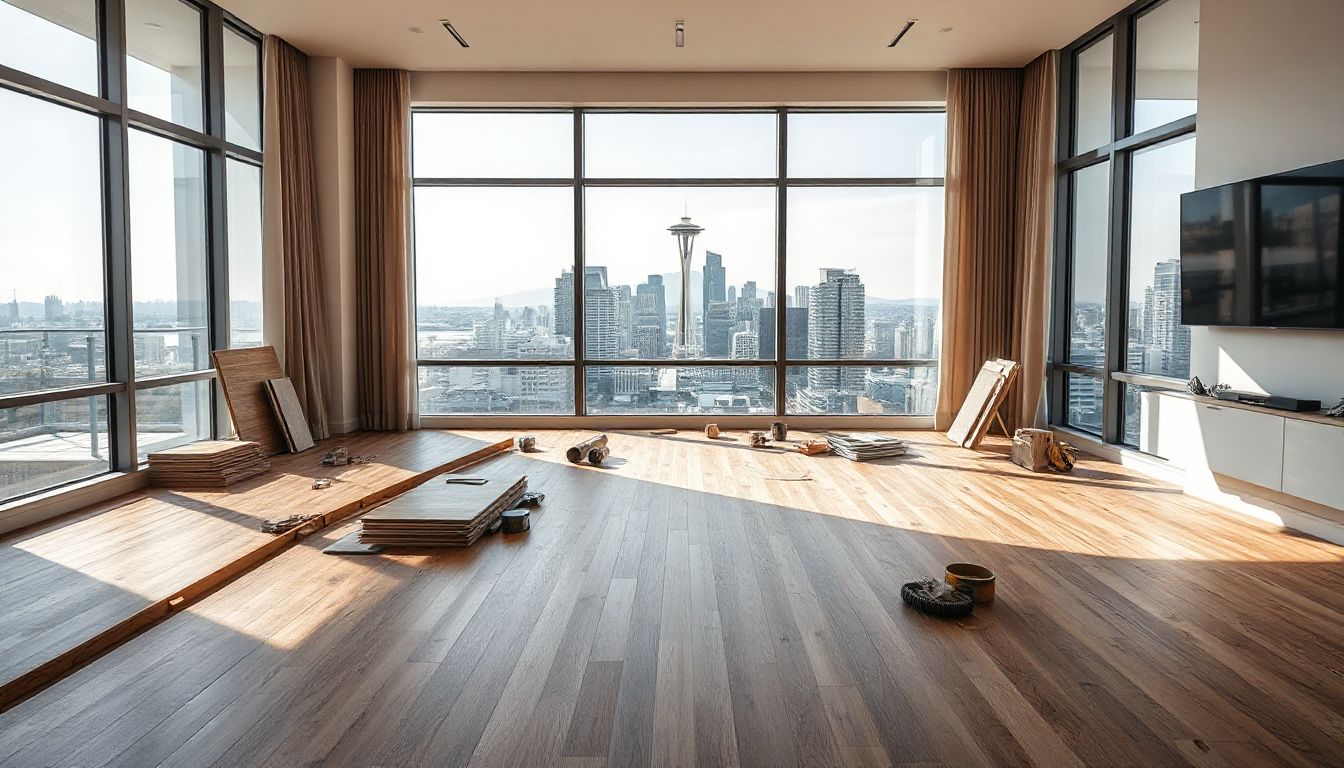Choosing the right flooring is a big decision for any homeowner in Seattle. Your floors are more than just a surface — they influence comfort, style, and how long your home lasts. Living in the Pacific Northwest means considering the region’s damp climate, high rainfall, and unique neighborhood styles. Whether you’re updating your home for better durability or a fresh look, understanding the process helps you make smarter choices. Replacing flooring involves planning, budgeting, and knowing what options fit your lifestyle. Knowing what to expect can save you time, money, and stress.
Understanding the Flooring Replacement Process in Seattle
The Basics of Flooring Replacement
Getting new floors installed usually follows a few steps. First, start with a consultation to discuss your needs and budget. Then, a professional assesses your space for moisture, damage, or structural issues. After choosing your material, the removal of old flooring begins — often the messiest part. Next, the surface gets prepared, which may include leveling or fixing underlying issues. Flooring is then installed and finished with cleaning. This process can take from a few days to a week, depending on the project size.
When to Consider Replacing Your Flooring
Notice signs your current floors need replacing? Worn-out carpet, scratched hardwood, or cracked tiles all point toward an upgrade. If your floors feel uneven or show signs of water damage, it’s time to act. In Seattle homes, moisture and humidity can cause wood to warp or rot. Outdated styles may also clash with your current decor or decrease home value. Experts recommend planning renovations during dryer months or before major holidays to avoid disruptions.
Hiring Local Flooring Contractors
Look for licensed and insured flooring specialists in Seattle. Ask around for recommendations and check reviews online. Interview potential contractors to understand their experience and services. Request examples of previous projects to see their work quality. Compare quotes carefully, making sure they include materials, labor, and disposal. A good contractor listens, explains options clearly, and offers a fair price.
Choosing the Right Flooring for Seattle Homes
Popular Flooring Options in Seattle
Seattle’s climate demands durable and moisture-resistant flooring. Hardwood is a classic choice, but it needs proper sealing. Laminate offers a budget-friendly alternative that looks like real wood but resists scratches. Vinyl and luxury vinyl planks stand up well against rain and humidity. Tile, especially in kitchens and bathrooms, is stylish and water-proof. Carpet adds warmth for bedrooms but can trap moisture if not maintained properly. Each option has pros and cons you should consider.
Factors Influencing Flooring Choices
Your lifestyle matters a lot. Busy families with pets might prefer vinyl or tile for easy cleaning. People with allergies should consider hypoallergenic flooring like bamboo or tile. Style preferences also impact your choice—do you want a modern, rustic, or elegant look? Think about sustainability too. Eco-friendly options like cork or recycled materials help reduce your carbon footprint. Pick materials that match your needs, budget, and home environment.
Expert Recommendations and Trends
Local interior designers suggest combining flooring types for a balanced look. For example, hardwood in living rooms with tile in bathrooms creates contrast. Trends point toward matte finishes and wider planks for a modern vibe. In Seattle, a trend is using reclaimed wood to add character. Many homeowners also choose eco-conscious products to lessen their environmental impact. These updates not only improve style but also increase your home’s value.
Cost Considerations and Budget Planning
Average Costs for Flooring Replacement in Seattle
Replacing flooring varies depending on what you pick. Expect to pay between $3 and $12 per square foot for materials. Labor costs will add $2 to $8 per square foot. For larger rooms, the total can reach several thousand dollars. Keep in mind that high-end hardwood or custom tile costs more than laminate or vinyl. Regional prices influence costs, with Seattle’s market pushing prices upward.
Hidden Costs to Watch For
Old flooring removal can be pricier if hazardous materials or uneven surfaces are involved. Sometimes, hidden issues like rot or moisture are discovered once the old floors come up — leading to additional repairs. Permit fees or inspections might be necessary for certain projects, especially if you’re altering the structure. Budget extra for these unexpected expenses to avoid surprises.
Tips for Budget Optimization
Focus on key areas like living rooms and kitchens to get the biggest impact. Use budget-friendly yet durable materials where appropriate. Get quotes from multiple contractors to compare prices and services. Consider doing some prep work yourself, such as moving furniture or cleaning the site. Choosing the right timing—off-peak seasons—can also save money.
Environmental and Sustainability Factors
Eco-Friendly Flooring Options
Sustainable flooring like bamboo grows fast and renews quickly. Cork is also renewable and offers good sound insulation. Recycled tile or rubber can give your home a unique look while saving resources. Look for certifications like LEED or GREENGUARD to ensure products meet strict health and sustainability standards. Many local stores in Seattle carry eco-friendly options, making it easier to choose green.
Impact of Climate on Flooring Longevity
Seattle’s damp environment challenges your floors. Moisture can cause wood to swell or promote mold growth. Installing vapor barriers and proper sealing extends the life of wood or laminate. Regular cleaning and moisture control programs keep your floors looking good longer. Humidity fans and dehumidifiers are handy tools to combat dampness and protect your investment.
Recycling and Disposal of Old Flooring
Disposing of old flooring responsibly is vital. Many materials like carpet and vinyl can be recycled. Local waste centers in Seattle accept bulky debris, but check if they recycle specific flooring types. Some manufacturers partner with recycling programs to repurpose old materials. Doing your part helps keep the environment clean and reduces landfill waste.
Maintenance and Care Post-Installation
Tips for Extending the Life of Your New Flooring
Keep your floors looking new longer with regular sweeping or vacuuming. Mop with gentle cleaners suited for your material. Use protective pads under furniture legs, especially on hardwood. Place rugs in high-traffic areas to prevent scratches and wear. Immediate cleanup of spills prevents staining or water damage.
Addressing Common Issues
Scratches on hardwood can often be fixed with touch-up kits. Stains on carpets can come out with proper cleaning solutions. Water damage requires professional repair, especially if it causes warping or mold. Keep an eye out for signs of damage and address issues early. Timely repairs can save you money and prolong your floors’ life.
Enhancing Longevity in Seattle’s Climate
Control humidity levels inside your home to prevent floor problems. Use dehumidifiers during the wet months. Protect flooring with area rugs in entry ways and high-traffic zones. Consider applying protective sealants suited for your floor type. Regular maintenance combined with climate awareness keeps your floors durable for years.
Conclusion
Replacing your floors in Seattle is a significant project that requires careful planning. Think about your home’s style, your lifestyle, and the climate before choosing materials. Hire licensed local experts for reliable installation. Budget wisely, factoring in hidden costs, and go for eco-friendly options when possible. Proper maintenance afterward ensures your investment lasts longer. Your new floors can transform your space, boost home value, and make your home more comfortable. Ready to start your flooring project? Take action today for a beautiful, long-lasting result.
Article Credit
Carpet to Go Flooring
7135 E W.T. Harris Blvd, Charlotte, NC 28227


